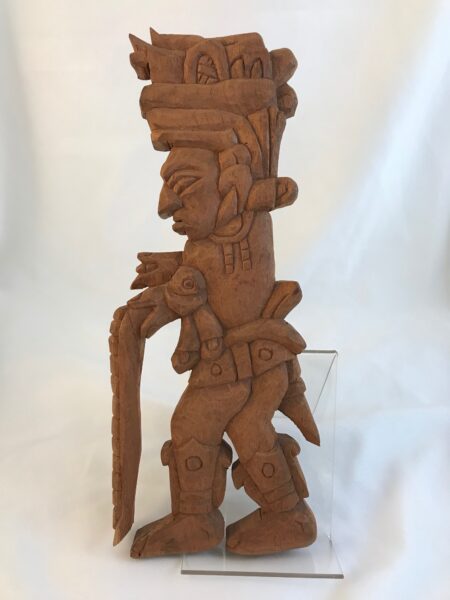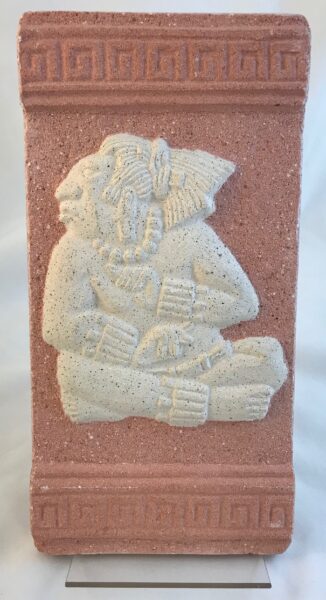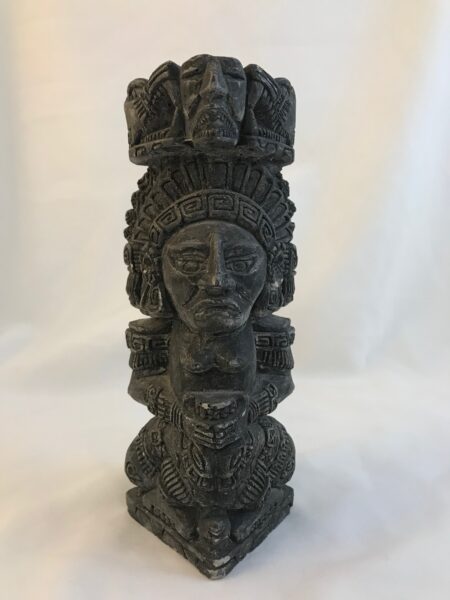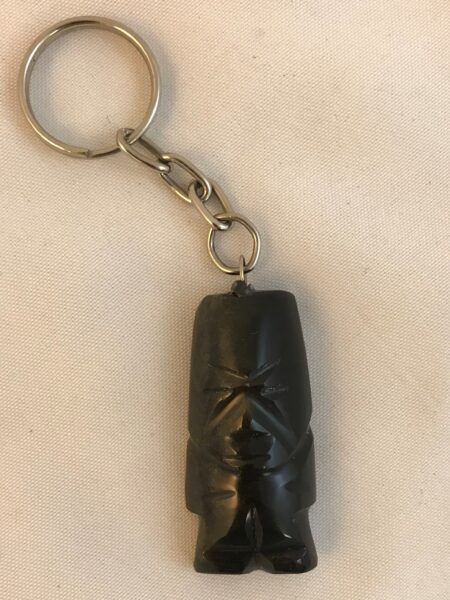The indigenous cultures of ancient Mesoamerica created a variety of highly sophisticated sculptures in different styles and materials, both as reliefs and as sculptures in-the-round. Many of these sculptures represent their religious beliefs, embodying the Mesoamerican pantheon of gods, while others depict the elite members of the nobility. Later Mestizo (mixed Hispanic and indigenous) cultures have continued to make sculptures in the styles and materials used by their indigenous ancestors. While some of these images express a continuation of ancient religious practices, many others serve as reproductions that the artists create to sell, in order to support their families. In addition, Mestizo artists also create new interpretations of old imagery, adapting the images and motifs to decorate to a variety of objects that may serve as souvenirs for the tourist trade.

Original: Maya culture, Classic period (250-900 CE)
Reproduction: Maya Mestizo cultures, 20th century (ca. 1988)
Wood, L. 14.7 cm x W. 2.4 cm x H. 35 cm
BFPC collection #2012.40
This wooden sculpture, made by a Maya Mestizo artist, depicts a late 20th-century interpretation of the Maya Maize god, known as Hun Hunahpu, in the act of sowing seeds. The Maya believed in a large pantheon of gods who were strongly connected to nature and to daily subsistence. Along with beans and squash, maize served as one of the three most important crops in Mesoamerica, and maize gods were therefore very important deities; Maya nobility often wore a maize silk headdress to associate themselves with the vitality and power of the maize god.
Like the crop itself progressed through different stages of growth, the maize god was depicted in different ways in Maya art according to whether the maize represented was at the sowing stage, the growing stage, the maturation stage, or the harvest stage. In this sculpture, the maize god is depicted as a strong, virile man, and he is identifiable by the stylized ear of corn in his headdress. The curved line that extends from his left hand is a pictographic symbol for the word “flowing,” indicating that the seeds are flowing from his hand to the earth, while the combination of an upside-down U shape and an X shape in his headdress could together be a simplified depiction of the Maya hieroglyph for k’an, meaning “ripe,” and likely refers to the ripe seeds that he sows.

Original: Maya culture, Classic period (250-900 CE)
Reproduction: Maya Mestizo cultures, Early 21st century
Concrete and pigment, L. 14.2 cm x W. 1.9 cm x H. 28 cm
BFPC collection #2013.39
This molded concrete sculpture was made by a Maya Mestizo artist in the style of the sculptural reliefs found at the site of Palenque, a major Classic period city in the western part of the Maya region that rose to greatness under the rule of King Pacal. The buildings at Palenque are highly decorated, featuring an abundance of stucco plaster reliefs that illustrate the Classic period Maya artists’ mastery of the human figure. These figures often represent important political and religious figures, including kings, queens, and deities.
The description on the back of this reproduction—likely added when it was offered for sale at a market–suggests that the figure represents the Maya depiction of the number zero, which could be represented by a symbol, an anthropomorphic head, or an anthropomorphic figure. However, this depiction does not resemble the common anthropomorphic figure variant of the Maya number zero, which usually shows a male figure wearing patches of spotted jaguar skin and holding his hand over his jaw. Instead, the cross-legged, seated pose and the position of the hands on this figure much more closely resemble the figure of Pacal that is depicted on the Oval Palace Tablet of Pacal, a famous sculpture found at Palenque. This reproduction sculpture therefore more likely represents a high-status noble man, perhaps even Pacal himself.

Original: Maya culture, Classic period (250-900 CE)
Reproduction: Maya Mestizo cultures, Early 21st century
Plaster and Pigment, L. 8.6 cm x W. 8.4 cm x H. 21.5 cm
BFPC collection #2008.9
Carved in high relief from a triangular column of plaster in high relief, this figural reproduction is based on a large-scale, early Classic period Maya stone sculpture. The figure depicts the great goddess of the Maya, who generally takes one of two very different forms: The young moon goddess of childbirth and medicine who is associated with lunar, rabbit, and water imagery, or the elderly female goddess Ix Chel, who acts as the young moon goddess’s counterpart. Ix Chel is the goddess of fate and is typically associated with childbirth, weaving, and embroidery as well as with water and fertility, and she is identifiable by the jaguar, serpent, or spindle imagery that she wears on her back.
This figure clearly depicts the great goddess, as she holds a water vessel, and as she is giving birth, with a child’s head emerging upside-down from between her legs. She is also clearly a depiction of Ix Chel, shown by the deep lines in her aged face as well as by the zoomorphic creatures resting above her headdress; the creatures have feline heads, but serpent-like bodies that trail down the figure’s back.

Original: Zapotec culture, Classic period (250-900 CE)
Reproduction: Zapotec Mestizo cultures, Early 21st century
Ceramic and pigment, L. 9.5 cm x W. 6.1 cm x H. 10 cm
BFPC collection #2016.41
This ceramic sculpture is based on the large ceramic figural urns that are found in mortuary contexts at Classic period Zapotec sites of the Oaxaca region in Mesoamerica. These urns were actually functional containers, with the opening of a cylindrical vessel hidden on the back side of the anthropomorphic figure, and the vessels likely held organic liquid offerings. With its cross-legged, seated posture, its hands on the knees, and the elaborate, fan-shaped feather headdress, this reproduction sculpture clearly takes the form, pose, and style of the Zapotec funerary urns, despite the fact that it does not have a vessel attached to the back.
Zapotec funerary urn figures wear elaborate garb, including great headdresses, large earspools, and other elite jewelry, but their outfits also include motifs worn by important Zapotec deities, and some figures even wear zoomorphic masks. With the five ears of corn featured in its headdress, this figure’s costume is likely meant to represent the garb of Pitao Cozobi, the Zapotec maize god. However, the urn figures are thought to represent an elite individual rather than the deity itself. Like the actual funerary urns, this reproduction figure wears a symbol on its chest that resembles a name hieroglyph, and such name hieroglyphs do not refer to the god represented by the figure’s costume; instead, the hieroglyph typically refers either to the elite individual buried in the tomb or to a high-status ancestor of that individual.

Original: Mezcala Preclassic/Formative period (1500-250 BCE)
Reproduction: Mezcala Mestizo cultures, Early 21st century
Obsidian, L. 2 cm x W. 1 cm x H. 4.2 cm
Hernandez collection #2012.14
The Mezcala culture, located in the region known as West Mexico, is best-known for having produced highly minimalistic, small-scale human effigies, masks, miniature temples, and animal effigies. These sculptures were carved out of a variety of different types of stone using the string-saw method, which involves painstakingly abrading the stone using a wet rope that was dipped in sand.
While this reproduction is made of obsidian, or volcanic glass–which is an uncommon material for the Mezcala–the simplified, abstracted form is typical of Mezcala human effigies, with simple grooves indicating the form of the head, face, arms, and legs. The Mezcala Mestizo artist who produced this figure has also made the figure into a practical and marketable souvenir by attaching it to a keychain.
For more information, you may contact the researcher(s) noted in the title of this exhibit entry, or Dr. Billie Follensbee, the professor of the course, at BillieFollensbee@MissouriState.edu

